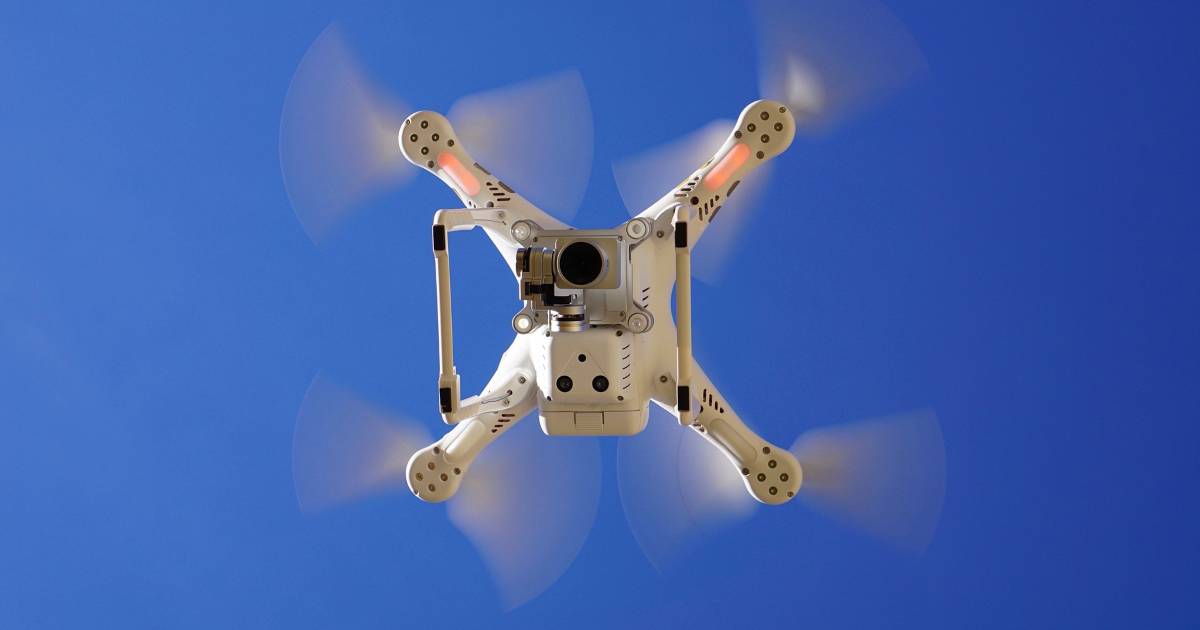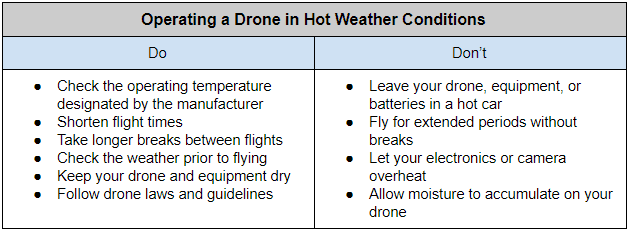Tips for Flying a Drone in Hot Weather Conditions this Summer
BY Isabella Lee
6 July 2018With record-breaking heat this summer, it’d be wise to gather some advice on flying a drone in hot weather conditions. The U.S. has been experiencing a heat wave with triple digit highs over the past couple weeks. The good news for UAV pilots is that most drones are built to withstand high temperatures — up to 104° Fahrenheit (F) in some cases. Follow our tips for flying a drone in hot weather this summer, and you should have an enjoyable flight.

Check the operating temperature designated by the manufacturer.
Drone manufacturers typically include an operating temperature range in the specs of their product. For example, the DJI Mavic Pro and Phantom 4 both list an operating temperature range of 32° to 104° F ( 0° to 40° C ). However, not all UAVs operate the same, and we recommend checking the specs provided by your drone’s specific manufacturer.
Don’t leave your drone, batteries, or other equipment in a hot car.
The interior of a parked car will heat to a much higher temperature than the outdoor temperature. With an outside temperature of 70° F, the inside temperature of a parked car can rise to 104° F within just 30 minutes. Prolonged exposure to high heat will reduce the life of the LiPo battery used in many UAVs. Additionally, internal wires and plastics could be susceptible to melting. Other equipment and the drone itself should be able to withstand very high heat, but it’s best not to take the chance if it can be avoided.
Be wary of electronics/cameras overheating.
Many drone operators who use iPhone as their camera report high temperatures causing their iPhones to shutdown. This could lead to a big disappointment if your camera shuts off mid flight, causing lost footage. While the drone itself can withstand high heat, the case could be different for electronics, cameras, and other attachments.
Shorten flight times and take breaks between flights.
One way to prevent overheating of your drone, electronics, or drone camera is to shorten flight times. Hot weather cause your drone’s motors to work harder to generate more lift. This can lead to shorter flight times, so plan accordingly. Additionally, breaks between flights allow your drone and electronics time to cool down and regain a stable temperature.
Keep your drone and equipment dry.
Many hot weather environments are accompanied by humidity. Even in the presence of clear, blue skies, humidity could cause your drone to come back damp with moisture. Humidity is the amount of water vapor in the air. When checking the weather, you might see humidity represented as a percentage — this is known as relative humidity. A reading of 100% relative humidity means that the air is saturated with the maximum amount of water vapor it can hold, creating the possibility of rain (although it can rain prior to a 100% relative humidity reading as well). We advise that you check the weather, including humidity readings and precipitation forecasts before you fly. Have a towel on hand to wipe down your drone after or between flights.
Follow laws and guidelines for flying near crowds
Warm weather tends to draw people outdoors. If you plan on flying near crowds of people, perhaps on a beach or at a park, be sure to follow your country’s drone laws and guidelines for flying near crowds. In the U.S., you should not fly over groups of people, public events, or stadiums full of people. In some instances, licensed commercial drone pilots can obtain a waiver to fly over crowds at special events. If you aren’t sure what the laws are in your country for flying a drone where crowds are present, visit our master list of drone laws organized by country.
To summarize, here are the do’s and don’ts of operating a drone in extremely hot weather.

While many areas of the world are experiencing record temperatures, it may be a good time to test out a thermal imaging camera on your drone. DJI’s Zenmuse XT is a thermal imaging camera for drones that provides rapid and reliable aerial thermal imaging. To learn more about how thermal imaging works check out this article about aerial thermography and its commercial applications.
As you’ve learned from this article, drones are pretty resilient to heat, but there are still some precautions you should take to protect the battery, camera, and other equipment if your drone flight location will have very high temperatures. The summer is an excellent time to capture outdoor footage, and we hope you take advantage of it. Just follow our drone flying tips for hot weather conditions and exercise drone safety for a positive flying experience.



